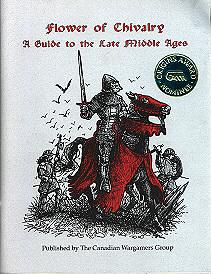

| |
This booklet is both an introduction to the period, a collection of scenarios,
and a rule system. Background material includes description of weapons and tactics, a
definition of chivalry, and a brief explanation of heraldry.
The rules are brief (4 pages of rules, 2 pages of tables) and easily learned. Figures are organized into units, which in turn make up larger units (Battles). There is a leader for each Battle, plus an overall army commander. Each turn, the player assigns an Aggression Level (Rash, Bold, Cautious, Defensive, and Prudent) to each Battle leader, then rolls (based on Aggression) to determine that leader's orders for the turn. Orders limit the range of actions available; the drawing of cards determines the total number of actions per side. Leaders accumulate a growing Battlelust rating as their units performs actions, increasing their exhaustion and limiting their actions. Rules also cover command control, missile and melee combat, bombards, handgunners, and personal challenges. The scenarios cover the Scottish Wars of Independence (Stirling Bridge, Falkirk, Bannockburn, Neville's Cross), Hundred Years War (Crecy, Poitiers, Agincourt, Formigny, Castillon), and War of the Roses (Mortimer's Cross, Barnet, Tewkesbury, Bosworth Field). A synopsis of each war is provided, as well as a campaign map and suggestions for creating a campaign. Army lists are provided for Dane, Saxon, Norman, Franks, Crusaders, Byzantines, Orders of Chivalry, Saracen, Moors, Slavs, English, French, Scots, Welsh, and War of the Roses. There is no points system for rating and comparing armies. | ||||||||
|---|---|---|---|---|---|---|---|---|---|
| Period | Late Middle Ages (1297 to 1485) | ||||||||
| Scale |
| ||||||||
| Basing |
One movement tray (suggested size for 15mm figures: 2" deep x 3" wide) holds all of the stands belonging to one unit. An infantry unit typically consists of six stands, each holding 1-4 figures; a cavalry unit consists of three stands. The number of figures per stand, or the size of the stand, does not matter. | ||||||||
| Contents | 76-page booklet. Requires use of a standard deck of playing cards (not included). | ||||||||
| Designer | Bruce McFarlane | ||||||||
| Publisher | Published 1993 by The Canadian Wargamers Group |
If you would like to add your opinion to this webpage, use the following form or send email to the editor.
If you know of other resources for this game, or if you have material you would like to make available to the Net, please let us know.
| Last Updates | |
|---|---|
| 26 October 1997 | page first published |
| Comments or corrections? | |